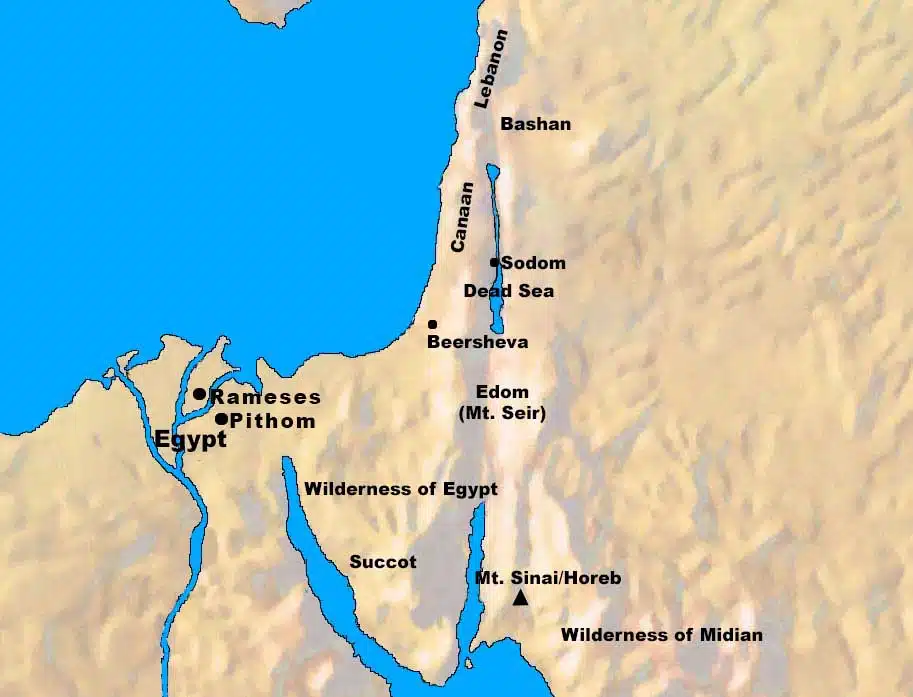After the instructions on how to create the linens of the tabernacle, the LORD then described how to make the boards and sockets that comprise the frame of the tabernacle.
Next, the frame of the tabernacle is described. It was comprised of the following:
First, the specifications for the boards for the tabernacle were given. The word translated boards (Heb. “qerashim”) here is translated “frames” in other translations (NIV, NET, NRSV, for example). It can also be translated “beams.” Many scholars think that solid pieces of the wood (like plywood) is not what is in view here. It is thought that the boards were frames made of vertical planks connected to each other with horizontal planks, forming a ladder-like construction.
The boards were to be made of acacia wood. This is the same type of wood used for other tabernacle items, including the ark (Exodus 25:10) and the table of showbread (Exodus 25:23).
Each “board” was to be ten cubits (15 feet or 4.5 meters) tall and one and a half cubits (2.25 feet or 0.68 meters) wide.
They needed to add two tenons (or pegs) for each board, and these were added so that the boards might be fitted to one another. This would result in a sturdy frame for the curtains and other decorations.
These specifications were the same for all the boards of the tabernacle.
Then the LORD describes how to put all of these components together to make the walls of the tabernacle. He explains what was to be done on each side.
They were to place twenty boards for the south side. This would make the south side (and the north side discussed below) about 45 feet (or almost 14 meters) long.
They needed to make forty sockets of silver under the twenty boards and place two sockets under one board for its two tenons and two sockets under another board for its two tenons. The sockets would be like metal feet to secure the boards and raise them from the ground (preserving them from moisture). This arrangement of the sockets allowed for easy setup and breakdown during their travels in the wilderness.
Next, for the second side of the tabernacle (the north side) twenty boards were described. Identical to the south side, the north side boards were to have forty sockets of silver; two sockets under one board and two sockets under another board.
The next section moves to the discussion of what was necessary for the rear of the tabernacle, which was to the west. On this side, they needed to make six boards, making the back side of the tabernacle around 15 feet (or a little more than 4.5 meters) wide.
In addition, they were to make two boards for the corners of the tabernacle at the rear. These two boards were designed to give added support to the rear corners of the tabernacle. To give added support, they were to be made double beneath, and together they shall be complete to its top to the first ring; thus it shall be with both of them: they shall form the two corners. These corner boards are thought by some to act as buttresses that support the tabernacle.
Summarizing the layout of the boards on the rear side of the tabernacle, the LORD stated that there shall be eight boards with their sockets of silver, sixteen sockets; two sockets under one board and two sockets under another board.
Biblical Text:
15 “Then you shall make the boards for the tabernacle of acacia wood, standing upright. 16 Ten cubits shall be the length of each board and one and a half cubits the width of each board. 17 There shall be two tenons for each board, fitted to one another; thus you shall do for all the boards of the tabernacle. 18 You shall make the boards for the tabernacle: twenty boards for the south side. 19 You shall make forty sockets of silver under the twenty boards, two sockets under one board for its two tenons and two sockets under another board for its two tenons; 20 and for the second side of the tabernacle, on the north side, twenty boards, 21 and their forty sockets of silver; two sockets under one board and two sockets under another board. 22 For the rear of the tabernacle, to the west, you shall make six boards. 23 You shall make two boards for the corners of the tabernacle at the rear. 24 They shall be double beneath, and together they shall be complete to its top to the first ring; thus it shall be with both of them: they shall form the two corners. 25 There shall be eight boards with their sockets of silver, sixteen sockets; two sockets under one board and two sockets under another board.
Check out our other commentaries:
-
Philippians 3:1 meaning
With self-awareness, Paul repeats a logical application of his main point to the Philippians to choose the same mindset Jesus chose: rejoice in the Lord....... -
Luke 15:3-7 meaning
Jesus told three parables in response to the Pharisees and scribes grumbling at how He mingles with sinners. This first parable is called “The Parable...... -
Luke 16:1-9 meaning
Jesus tells His disciples the Parable of the Unrighteous Steward. It is about a manager of a rich man’s estate who is fired for bad...... -
Matthew 18:6-7 meaning
Having taught about greatness in the kingdom, Jesus now teaches about failure. He teaches that becoming a stumbling block to little ones is an immediate...... -
Deuteronomy 17:1 meaning
Along with prohibiting pagan objects in or near the central sanctuary, Moses tells the Israelites to avoid offering any defective animal to the Suzerain (Ruler)......



